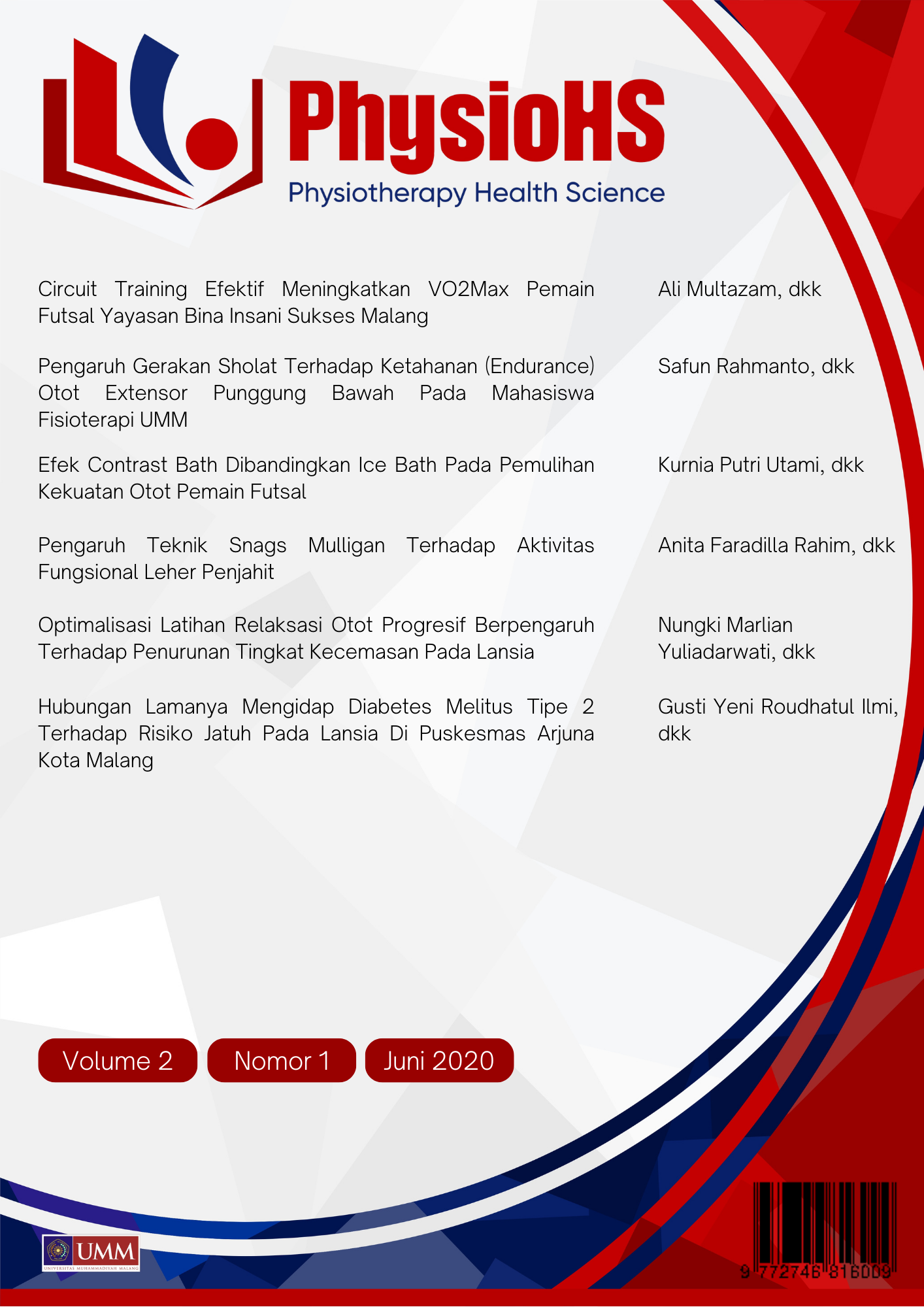Hubungan Lamanya Mengidap Diabetes Melitus Tipe 2 Terhadap Risiko Jatuh Pada Lansia Di Puskesmas Arjuno Kota Malang
DOI:
https://doi.org/10.22219/physiohs.v1i2.13889Abstract
Diabetes melitus yaitu salah satu kelompok dari metabolik dengan karakteristik hiperglikemia karena adanya gangguan pada sekresi insulin atau kinerja produksi insulin. Hiperglikemia yang berkelanjutan pada pengidap diabetes melitus akan menyebabkan kerusakan dan disfungsi pada organ lain khususnya pembuluh darah, system musculoskeletal, indera pengelihatan, jantung yang dapat mempengaruhi risiko jatuh pada pengidap diabetes tersebut. Penelitin ini merupakan jenis penelitian observasional dengan metode cross sectional. Dengan menggunakan teknik quota sampling diperoleh jumlah sampel sebanyak 46 orang. Untuk mengukur risiko jatuh dilkukan pengukuran keseimbangan menggunakan Berg Balance Scale. Data status diabetes diperkuat dengan data sekunder dan rekam medis responden di Puskesmas Arjuno Kota Malang. Dari 46 orang sampel terdapat 19 responden (41,3%) berisiko jatuh tinggi, 22 responden (47,8%) berisiko jatuh sedang, 5 responden (10,9%) berisiko jatuh rendah. Setelah dilakukan uji korelasi menggunakan spearman’s correlation didapatkan hasil nilai p= 0,000 yang menunjukan adanya hubungn lamanya mengidap diabetes melitus dengn risiko jatuh dengan nilai r= 0,864 yang menunjukkaan adanya hubungan sangat kuat antar variabel. Ada hubungan antara lamanya mengidap diabetes melitus tipe 2 tehadap risiko jatuh.
Downloads
References
American Diabetes Association., (2014). Diagnosis and Classification of Diabetes Melitus. Diabetes Care. 37: 1.
Bogdan Timar, Romulus Timar, Laura Gaita, Cristian Oance, Codrina Levai, Diana Lungeanu (2016) : The Impact of Diabetic Neuropathy on Balance and on the Risk of Falls in Patients with Type 2 Diabetes Mellitus : A Cross-Sectional Study.
Chiba Y,Yoshiyuki Kimbara, Remi Kodera, et al (2015). Risk factor sassociated with falls in elderly patients with type 2 diabetes. Journal of Diabetes and Its Complications. 29898–902.
D’Silva L.J, James Lin, HinrichStaecker, Susan L. Whitney, Patricia M. Kluding. (2016) Impactof Diabetic Complications on Balance and Falls: Contribution of the Vestibular System. Phys Ther.;96:400–409.
Mauk, K.L. (2010) Gerontological nursing competencies for care (2nd ed). Sudbury: Janes and Barlett Publisher.
Roman de Mettelinge T, Cambier D, Calders P, Van Den Noortgate N, et al (2013). Understanding the Relationship between Type 2 Diabetes Mellitus and Falls in Older Adults: A Prospective Cohort Study. Journal of pone PLoS ONE 8(6):e67055. doi:10.1371
Sadaqat H, Sara Amin, Arshad Nawaz Malik. 2012. Kinesthetic and Proprioceptive Impairments in Diabetic Patient. Journal of Riphah International University Islam abad.
Tilling, L.M.T, Khaled Darawil, Mary Britton.(2005). Falls as acomplication of diabetes mellitus in older people. Journal of Diabetes and Its Complications 20 (2006) 158– 162Lu F-P.
Timar B, Timar R, Gaiță L, Oancea C, Levai C, Lungeanu D, (2016) The Impactof DiabeticNeuropathy on Balance and on the Risk of Falls in Patientswith Type 2 DiabetesMellitus: A Cross-Sectional Study. Plos one journal of pone ONE11(4):1371/154654.
Downloads
Published
How to Cite
Issue
Section
License
Authors who publish with Physiotherapy Health Science (PhysioHS) agree to the following terms:
- For all articles published in Physiotherapy Health Science (PhysioHS), copyright is retained by the authors. Authors give permission to the publisher to announce the work with conditions. When the manuscript is accepted for publication, the authors agree to automatic transfer of the publishing right to the publisher.
- Authors retain copyright and grant the journal right of first publication with the work simultaneously licensed under a Creative Commons Attribution-ShareAlike 4.0 International License that allows others to share the work with an acknowledgement of the work's authorship and initial publication in this journal.
- Authors are able to enter into separate, additional contractual arrangements for the non-exclusive distribution of the journal's published version of the work (e.g., post it to an institutional repository or publish it in a book), with an acknowledgement of its initial publication in this journal.
- Authors are permitted and encouraged to post their work online (e.g., in institutional repositories or on their website) prior to and during the submission process, as it can lead to productive exchanges, as well as earlier and greater citation of published work (See The Effect of Open Access).
This work is licensed under a Creative Commons Attribution-ShareAlike 4.0 International License.





















